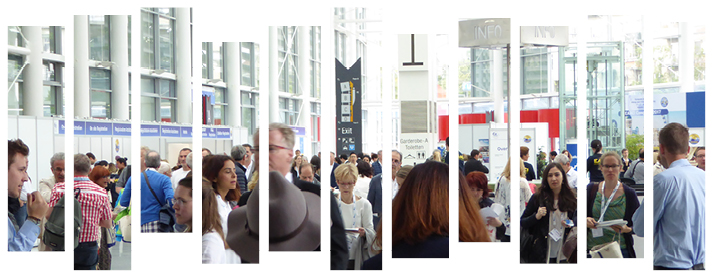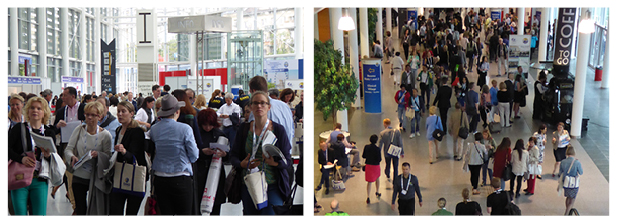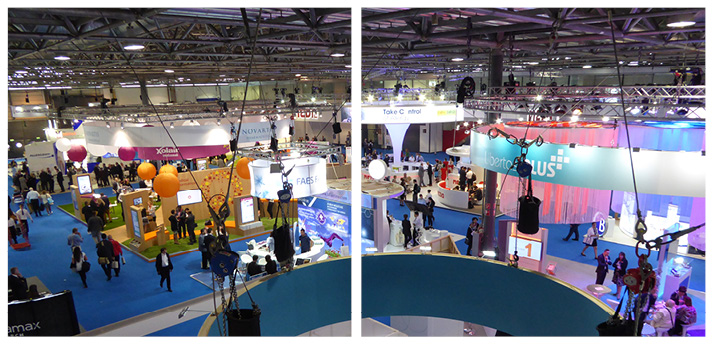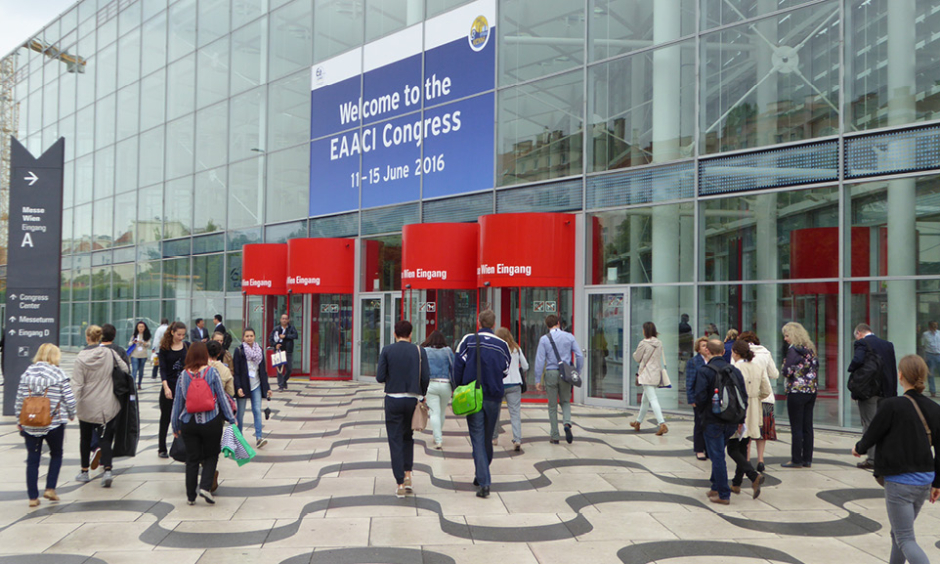The largest and most populated city in Austria, Vienna has for centuries been the musical capital of Europe and this year hosts the annual European Academy of Allergy and Clinical Immunology (EAACI) Congress with the ideal location for its ‘Waltzing with Allergens’ theme. The melodious theme of this event was given the ideal impetus for orchestrating its attendees in a Congress Ball in a city that remains internationally renowned for its music and culture.
Last year, the EAACI 2015 Congress in the Spanish city of Barcelona attracted close to 8,000 attendees from more than 100 different countries. EAACI 2016 remained equally attractive this year by providing over 1,800 abstracts for discussion and presentation in oral presentations, poster discussions, and guided poster presentations. The congress was also an opportunity for the EAACI to celebrate its 60th year of dedication to improving the health of all people affected by allergic diseases and asthma. An exhibition was featured at the event detailing the history of the EAACI and highlighting the advances made in the field of allergy and immunology over the past decades.
Over 100 authors at the congress were the recipients of awards for abstract presentations deemed the best overall in the oral abstract, poster discussion, and thematic poster sessions. Each received a certificate of recognition and a €200 prize. The EAACI also continued its annual tradition of honouring European clinicians and researchers who have made significant contributions to the field of allergology, bestowed this year upon the following four individuals.
Presented at the EAACI 2016 opening ceremony, the Daniel Bovet Award for improving treatment and prevention of allergic disease went to Prof Erkka Valovirta, Department of Clinical Medicine, University of Turku, Turku, Finland. The EAACI recognises the work of Prof Valovirta in advocating the treatment of allergies in Europe, including his time spent as President of the European Federation of Allergy and Airways Disease Patients’ Associations (EFA) from 1997–2003. Prof Valovirta is also known for his work in allergology societies such as the EAACI and the World Allergy Organization (WAO), and for the last 8 years has been dedicated to practical field work as part of the Finnish Allergy Programme.
The 2016 Clemens von Pirquet Award for Clinical Research was awarded to Prof Magnus Wickman, Institute of Environmental Medicine, Karolinska Institutet, Solna, Sweden. Prof Wickman was one of the first scientists to study the natural history of allergic disorders, atopic dermatitis, and asthma in childhood and adolescents in birth cohorts. His work is recognised for uniting population-based medicine and epidemiology with clinical medicine, molecular allergology, and genetics and epigenetics. From 1994–2014 he was the principal investigator of the Swedish population-based cohort (BAMSE). Investigating the influence of environmental and other factors for the development of atopy and asthma, Prof Wickman was a leader of the project which followed 4,000 newborn individuals until early adulthood.
Prof Jan de Monchy, Department of Internal Medicine, University Medical Center Groningen, Groningen, Netherlands, was the recipient of the 2016 Charles Blackley Award for Promotion of the Speciality. Prof de Monchy has long been working in the field, registering as an allergologist in 1980 and has been recognised for his strong advocacy of the speciality throughout his career. In 2007, he became the President of the European Union of Medical Specialists (UEMS) for the allergology board where he remained for 8 years, whilst also serving the EAACI as an adjunct member of the Executive Committee. Prof de Monchy has also been recognised for his involvement in the publication of an important paper, ‘Allergology in Europe: The Blueprint’. It provided a description of the rationale for the medical speciality of allergology, underlining the need for quality in allergy healthcare and the importance of allergy centres.
Finally, Prof Cezmi Akdis, Director of the Swiss Institute of Allergy and Asthma Research (SIAF), Davos, Switzerland, has been the recipient of several international awards, including the Ferdinand Wortman Prize in 1996, the Swiss Society Immunology Award in 1996 and 1998, and the WAO Award in 2013. Prof Akdis has been recognised for a long and distinguished career in allergy and immunology research. He has published more than 450 papers and the focus of his research incorporates the areas of developing novel vaccines and treatment modalities, the epithelial barrier in asthma and allergies, and disease endotypes.
This year’s EAACI 2016 was an informative event that provided updates on the latest developments and emerging trends in the allergy and immunology field. In particular, it highlighted the increasing importance of improving allergy prevention and care, whilst also stressing the pressing need for all of Europe to tackle allergic diseases together. These are issues requiring close attention and substantial effort from everyone involved in the field to tackle. We look forward to checking in next year at EAACI 2017 in Helsinki, Finland, to hear about the progress made.

President of EAACI Draws Attention to Novel Precision Medicine
THE PRESIDENT of the EAACI has highlighted the importance of precision medicine for the management of allergic diseases.
Precision medicine is an innovative therapeutic approach, which takes into account individual variability in genes, environment, and lifestyle. It differs from personalised medicine by focussing on which current approaches will be effective with patients based on particular factors, rather than developing unique treatments for them. It is considered widely relevant to the management of asthma, rhinitis, food allergy, and atopic dermatitis. Its approach consists of treatments based on molecular, immunologic, and functional endotyping of the disease, patient participation in the decision-making process of therapeutic actions, and the consideration of predictive and preventative aspects of the treatment.
“Wide consensus between academia, governmental regulators, and industry for further development and application of precision medicine in management of allergic diseases is of utmost importance,” explained Dr Antonella Muraro, President of the EAACI, Zurich, Switzerland. “Improved knowledge of disease pathogenesis together with defining validated and qualified biomarkers are key approaches to precision medicine,” she added.
According to a press release from the 60th EAACI congress dated the 13th of June 2016, bringing precision medicine into clinical practice could help reduce the epidemic of allergies and chronic airways diseases. It mentions progress having already been made in profiling Type II immune response-driven asthma. However, for precision medicine to be effective within healthcare centres substantial medical advances first need to be made. This includes improved disease taxonomy, complete patient monitoring using novel digital technology, and an improved understanding and common usage of disease phenotypes, endotypes, and biomarkers preferentially at the point of care.

Biomarkers Recognised as an Effective Approach for Allergy Diagnosis and Treatment
BIOMARKERS are an important discovery for the implementation of precision medicine approaches aimed towards improving allergy diagnosis and treatment.
This is according to an EAACI press release dated 13th June 2016. Also mentioned was that biomarkers were a central topic of research presented at EAACI 2016, emphasising its importance as a building block towards precision medicine in regards to allergic diseases.
The value of biomarkers in the paediatric diagnosis and treatment of allergies has also been identified in research. Researchers from London and Manchester universities in the UK presented a study at EAACI 2016 which revealed how the identification of specific allergens could assist clinicians in tackling the symptoms of allergic diseases. The research team discovered a group of allergens unique to children with a persistent controlled wheeze. This would allow the children with the allergens present to be identified during their early years of life as susceptible to the symptom of wheezing, which could inform early interventions for treatment.
Additionally, the potential for future therapeutic approaches was identified as the result of profiling microRNAs (miRNAs) on eosinophils, specialised immune system cells. The researchers found that the profile could discriminate between asthma and a healthy status. This was described as a ‘miRNAs signature’ that could be used in a similar approach as a biomarker towards identifying asthma pathology. This could offer new insights into the disease and inform the development of effective treatments in the future.

EAACI Publishes a User’s Guide to Molecular Allergology
A WORLD DEBUT has been made in a recent announcement by EAACI regarding the launch of their new user guide in molecular allergology. This is according to an EAACI press release dated the 13th June 2016, which also explains that the guide is the result of contributions from over 50 key opinion leaders. The new developments in molecular allergology have been brought together into the impressive guide allowing clinicians to obtain detailed information on sensitisation patterns. It will also facilitate more accurate interpretation of allergic symptoms.
The information provided in the book is seen as an example of how molecular allergology is linked to precision medicine and its advancement of the therapeutic benefits of this approach. It is claimed to provide the basis for a more refined and earlier diagnosis of allergic reactions, allowing an individualised management of the patient and approaches to prevention.
The book can be found on the EAACI website and its contents are split into three parts, beginning with the general concepts of molecular allergology. It then moves on to its various applications in clinical practice, offering information on various allergies such as soy allergy, peanut allergy, and cockroach allergy. Finally, the book explores the clinical relevance of cross-reactive molecules such as those making up the prolifin protein; which between 10% and 60% of pollen allergic patients are sensitised to according to this. In the preface, the EAACI President, Dr Antonella Muraro, explains the huge significance of the new guide at a time when patients of all ages are suffering from the steady rise in incidence of allergic disease, anaphylaxis, and comorbidities with allergy. She also calls for better education of healthcare professionals to address this important issue, and thus the reasoning behind the EAACI’s timely publication of the user guide on molecularallergology describing its components, the clinical benefits of testing for components, as well as how to interpret results including understanding cross-reactions.

EAACI Calls for National Efforts in Tackling Allergies Across Europe
THE CO-ORDINATED efforts of policy makers across Europe is required in order to tackle the burden of allergies on public health issues according to EAACI.
The EAACI has called upon national and European Union (EU) policy makers to co-ordinate their actions towards improving allergy prevention and care. According to an EAACI press release dated 13th June 2016, allergies are a public health concern on a pandemic scale which require immediate and concerted action. It is believed that by 2025 more than 50% of all Europeans will suffer from an allergy. Therefore, disease prevention is considered vital to controlling the burden to public health that is likely to skyrocket in the coming years. This includes not only the burden on patients’ quality of life, but also healthcare costs, economic loss due to missed workdays, and reduced productivity from the impact of the symptoms of allergy.
During the EAACI 2016 congress, meetings were held to progress EU policies and discuss concerted actions to bring about the necessary changes to tackle the issues of allergies in Europe. Among those in attendance at the meetings were EU stakeholders, representatives of EAACI leadership, EU allergy patient advocates, and members of industry.
In April 2016, the European Parliament Interest Group on Allergy and Asthma highlighted the health concern of allergies through an event which involved over 400 members of the public and included members of the European Parliament. The ‘Test, Inform, Prevent’ event was held in the European Parliament in Brussels which performed skin-prick allergy tests. It found that 53% of the participants tested positive for an allergy who were then provided with further information about how allergies can be diagnosed, managed, and prevented. Sixteen MEPs took the test and three of them subsequently joined the interest group.







